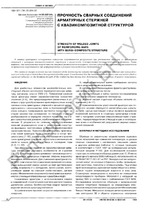Прочность сварных соединений арматурных стержней с квазикомпозитной структурой = Strength of welded joints of reinforcing bars with quasi-composite structure

Authors
Date
2010Publisher
xmlui.dri2xhtml.METS-1.0.item-identifier-udc
621.791.05:691.87Bibliographic entry
Мойсейчик, Е. А. Прочность сварных соединений арматурных стержней с квазикомпозитной структурой = Strength of welded joints of reinforcing bars with quasi-composite structure / Е. А. Мойсейчик // Строительная наука и техника = Construction science and engineering. – Минск : МАИС, 2010. – № 4. – С. 60-70.
Abstract
В статье приводятся исследования изменения сопротивления разрушению при растяжении образцов из арматурных стержней с исходным квазикомпозитным строением и различными конструктивно-технологическими дефектами. Также выявлено, что механические воздействия на стержни (незначительные надрезы, насечки зубилом) несущественно сказываются на их временном сопротивлении при деформировании в условиях положительных температур. The studies of changes in tensile fracture resistance of the reinforcing bar samples having guasi-composite structure and various struc-tural and technological defects have been presented in this paper. It was founded that the mechanical effects (minor cuts and notches] had no significant influence on the breaking strength of the reinforcing bars during their deformation under conditions of positive temperatures.
